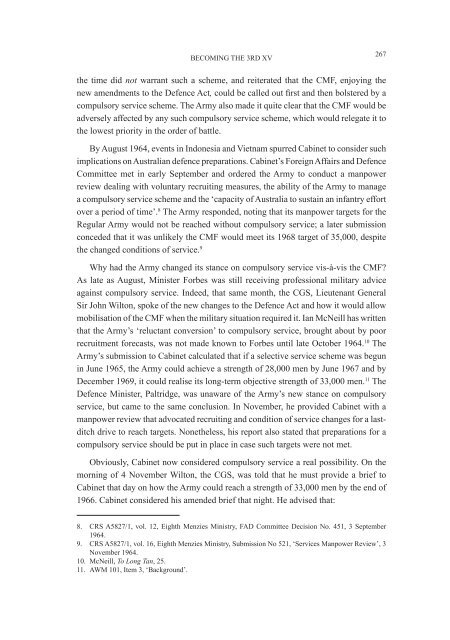conference proceedings - Australian Army
conference proceedings - Australian Army
conference proceedings - Australian Army
Create successful ePaper yourself
Turn your PDF publications into a flip-book with our unique Google optimized e-Paper software.
BECOMING THE 3RD XV<br />
the time did not warrant such a scheme, and reiterated that the CMF, enjoying the<br />
new amendments to the Defence Act, could be called out first and then bolstered by a<br />
compulsory service scheme. The <strong>Army</strong> also made it quite clear that the CMF would be<br />
adversely affected by any such compulsory service scheme, which would relegate it to<br />
the lowest priority in the order of battle.<br />
By August 1964, events in Indonesia and Vietnam spurred Cabinet to consider such<br />
implications on <strong>Australian</strong> defence preparations. Cabinet’s Foreign Affairs and Defence<br />
Committee met in early September and ordered the <strong>Army</strong> to conduct a manpower<br />
review dealing with voluntary recruiting measures, the ability of the <strong>Army</strong> to manage<br />
a compulsory service scheme and the ‘capacity of Australia to sustain an infantry effort<br />
over a period of time’. 8 The <strong>Army</strong> responded, noting that its manpower targets for the<br />
Regular <strong>Army</strong> would not be reached without compulsory service; a later submission<br />
conceded that it was unlikely the CMF would meet its 1968 target of 35,000, despite<br />
the changed conditions of service. 9<br />
Why had the <strong>Army</strong> changed its stance on compulsory service vis-à-vis the CMF?<br />
As late as August, Minister Forbes was still receiving professional military advice<br />
against compulsory service. Indeed, that same month, the CGS, Lieutenant General<br />
Sir John Wilton, spoke of the new changes to the Defence Act and how it would allow<br />
mobilisation of the CMF when the military situation required it. Ian McNeill has written<br />
that the <strong>Army</strong>’s ‘reluctant conversion’ to compulsory service, brought about by poor<br />
recruitment forecasts, was not made known to Forbes until late October 1964. 10 The<br />
<strong>Army</strong>’s submission to Cabinet calculated that if a selective service scheme was begun<br />
in June 1965, the <strong>Army</strong> could achieve a strength of 28,000 men by June 1967 and by<br />
December 1969, it could realise its long-term objective strength of 33,000 men. 11 The<br />
Defence Minister, Paltridge, was unaware of the <strong>Army</strong>’s new stance on compulsory<br />
service, but came to the same conclusion. In November, he provided Cabinet with a<br />
manpower review that advocated recruiting and condition of service changes for a lastditch<br />
drive to reach targets. Nonetheless, his report also stated that preparations for a<br />
compulsory service should be put in place in case such targets were not met.<br />
Obviously, Cabinet now considered compulsory service a real possibility. On the<br />
morning of 4 November Wilton, the CGS, was told that he must provide a brief to<br />
Cabinet that day on how the <strong>Army</strong> could reach a strength of 33,000 men by the end of<br />
1966. Cabinet considered his amended brief that night. He advised that:<br />
8. CRS A5827/1, vol. 12, Eighth Menzies Ministry, FAD Committee Decision No. 451, 3 September<br />
1964.<br />
9. CRS A5827/1, vol. 16, Eighth Menzies Ministry, Submission No 521, ‘Services Manpower Review’, 3<br />
November 1964.<br />
10. McNeill, To Long Tan, 25.<br />
11. AWM 101, Item 3, ‘Background’.<br />
267

















